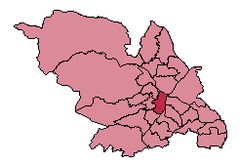Sheffield Central ward
Coordinates: 53°22′34″N 1°28′52″W / 53.376°N 1.481°W
| Central | |
|---|---|
 Shown within Sheffield | |
| District | Sheffield |
| Ceremonial county | South Yorkshire |
| Region | Yorkshire and the Humber |
| Country | England |
| Sovereign state | United Kingdom |
| UK Parliament constituency | Sheffield Central |
| Councillors | |
|
Jillian Creasy (Green Party) Jean Cromar (Labour Party) Bernard Little (Green Party) | |
| Numbers | |
| Population (2001) | 17,300 |
Central ward—which includes the districts of Broomhall, Highfield, Sharrow, and the city centre—is one of the 28 electoral wards in City of Sheffield, England. It covers the central area of the city, an area of 4.8 km2. The population of this ward in 2001 was 17,300 people in 7,300 households. It is one of the wards that make up the Sheffield Central constituency.
Districts of Central ward
City Centre
Sheffield City Centre (grid reference SK354872)—often just referred to as town—is the area within roughly 1.2 km (¾mile) of Sheffield Cathedral. It is encircled by the Inner Ring Road, a circular route started in the late 1960s and now completed in 2008. As well as the cathedral, notable buildings in the city centre include the Grade I listed Town Hall, the City Hall, and the Winter Garden. Several areas of the city centre have been designated as "quarters". Of these, the Devonshire Quarter and Cultural Industries Quarter are the best known.
Sharrow
Sharrow (grid reference SK344857) is an inner city district located directly south west of Sheffield city centre.
Highfield
Highfield (grid reference SK351857) is an inner city district of Sheffield centred on London Road. A large Chinese ethnic population lives in the area. Olympic heptathlon champion Jessica Ennis-Hill grew up there.
Broomhall
Broomhall (grid reference SK342865) is a district of Sheffield to the west of the city centre. It occupies the land that once belonged to Broom Hall, a historic mansion[1] still in existence today, which dates from at least the 15th century when it was the principal residence of the Swift family, who had inherited from the Wickersleys.[2] In 1791 the hall was owned by the reverend James Wilkinson, vicar of Sheffield, when it was attacked and set on fire by a mob rioting against the Enclosure of land act.
In 1973 David Mellor began manufacturing his own cutlery designs here. To house his factory he renovated a large historic mansion, Broom Hall. The building was then derelict. The machines were moved into the extensive Georgian wing. The conversion of the building received a European Architectural Heritage Award. As well as introducing new concepts in cutlery he rethought the traditional methods of production. Workers in the Sheffield cutlery industry had up to then specialised in a single operation, but he introduced a new system whereby his cutlery makers rotate from task to task, increasing job satisfaction through a sense of involvement in the project as a whole.
The Broomhall Park Association was formed in 1967 by residents living in Broomhall who wanted to ensure that - at a time when the area was threatened with unrestricted developments - the special character of Broomhall was maintained and enhanced for the future. Broomhall is close to the University of Sheffield and is a diverse area, mixing larger houses and student accommodation. Parts of it had a reputation for being a red-light district several years ago and it is now home to a large Somali community. It has local transport connections to Meadowhall, Hillsborough, Stannington and Chapeltown.
References
| |||||||||||||||||||||||||